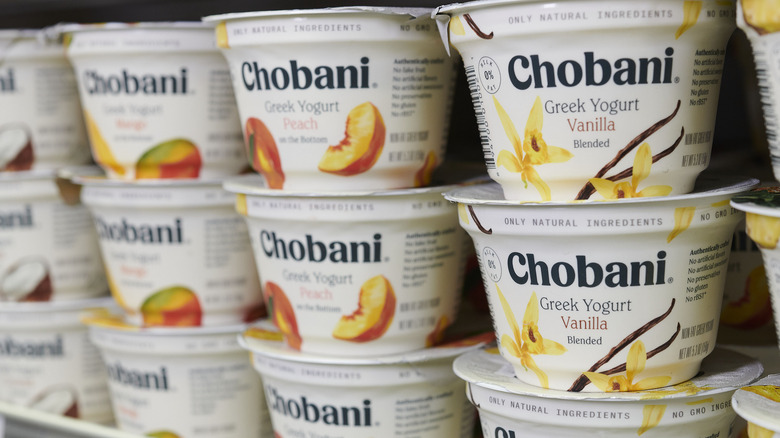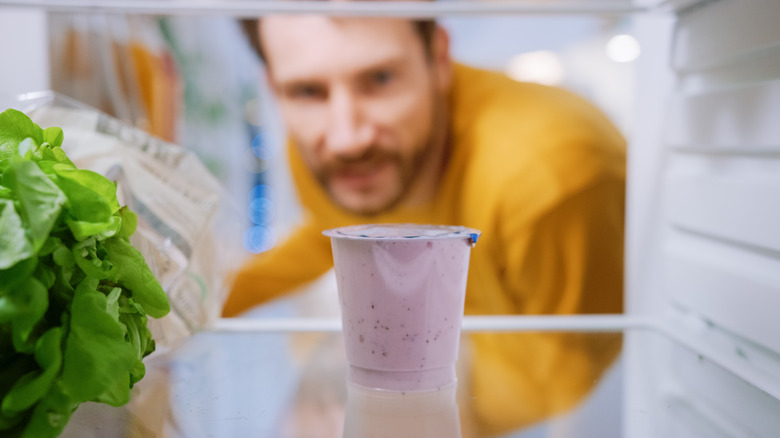Can You Eat Yogurt After It Expires?
Here's a scenario you may be familiar with: after looking in the fridge for something to eat for breakfast or a snack, we come across yogurt — except it's past the expiration date. However, it hasn't been opened yet, and it seems like it might still be safe to eat. But is it?
The short answer is yes but with some caveats. If the container is unopened, the yogurt may be edible after the date listed, but only if it first passes the look and smell test. As long as the yogurt isn't showing any signs that it has gone bad, such as a foul odor or mold growth — both of which are, luckily, easy to spot — it should be safe to consume. What manufacturers print on yogurt is a best-by date because expiry, particularly with fermented products, is harder to predict with great accuracy. So, while it's best to take what's on the package with a grain of salt, one must do their due diligence to avoid ingesting something spoiled.
On the other end of the spectrum, the answer might not be so easy if the yogurt container has been opened. After the yogurt has been opened, experts suggest eating it within seven to 14 days because the chances of mold or yeast growing increase as soon as you open it.
How long past the expiration date is it safe to eat the yogurt?
Now that we know it's possible to eat yogurt past the listed date, you may wonder how long you have until it's no longer safe. The USDA recommends that you throw out dairy products — including yogurt — after they have been in your fridge (unopened) for a maximum of two weeks, regardless of the expiration date. However, the USDA also clarifies that if you opt to freeze your yogurt instead, you have a bigger window — in this case, you can keep the unopened yogurt in your freezer for a maximum of two months.
There is one crucial exception to this: if the yogurt has fruit at the bottom, you have to be even more cautious about eating it past the date. This is because it is even likelier for mold or yeast to grow in the presence of fresh fruit.
How to tell if yogurt is bad?
Now, let's get into the specifics of how to tell if your yogurt has gone bad. As mentioned above, the smell and sight of it have a lot to do with its freshness. You may be familiar with seeing a little puddle of liquid at the top of your yogurt container, which is normal, but too much liquid is a bad sign. Further, if you see large clumps, you may want to pass on the yogurt that day and throw out the container. Additionally, you want to look for signs of mold or yeast — this includes the yogurt looking discolored, such as a blue, green, or gray tint.
As for the smell, it should be pretty obvious if something is off — if it smells rotten or bad in any way, then throw it out. Finally, if it looks and smells fine, but something about it tastes off to you, it's best to be safe and throw it out, even without the other signs of spoilage.
What's the best way to store yogurt?
To maximize yogurt freshness, you need to keep it in the refrigerator as long as possible — so when you get home from the grocery store, pop it in right away. If you have a bigger yogurt container and only want one portion, then make sure you tightly seal the container once you've gotten what you need and immediately put it back in the fridge. If you accidentally leave it out for two hours or more, you have to throw it out.
Additionally, where you put the yogurt in your fridge matters too — namely, you should never keep yogurt in the door of your fridge. This is because the temperature of the fridge door is more subject to change as it's constantly getting opened and closed. Finally, there is the option to freeze the yogurt, which will give it the most shelf life. Freezing works especially well when you buy yogurt in individual containers so that you only have to thaw it one portion at a time — this will keep it the freshest. If you freeze, then thaw an entire container, all of the other practices we've laid out should follow. When it comes time to thaw, you can leave the yogurt in the fridge overnight, and then it will be ready to eat in the morning.



